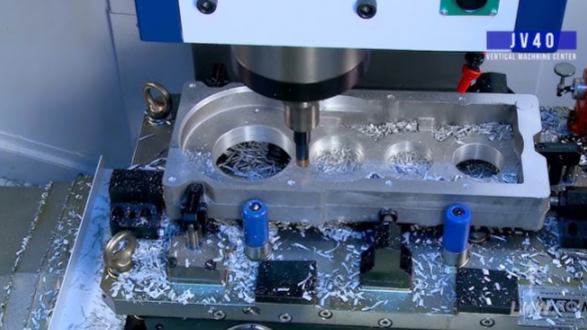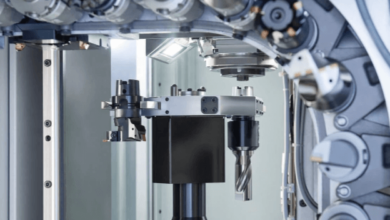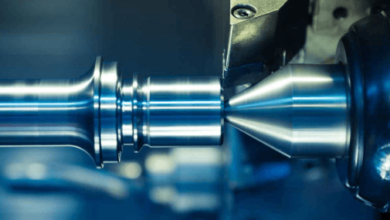How does a VMC work?

Introduction to VMC
Vertical Machining Centers (VMC) stand as pivotal assets in modern manufacturing, tasked with operations like milling, drilling, and tapping. Their design is characterized by a vertically oriented spindle that facilitates operations on a stationary workpiece, optimizing chip evacuation and accommodating hefty cutting loads. This section will delve into the VMC’s basic functionality and historical development within industrial contexts.
Components of a VMC
The operational efficiency of a VMC hinges on several core components, each integral to its precision machining capabilities:
- Structure and Frame: The robust frame not only supports the entire machine assembly but also absorbs vibrations, ensuring stability during operations.
- The Spindle: Heart of the VMC: Holding and rotating the cutting tools, the spindle’s performance is critical for the machine’s overall output and precision.
- Tool Magazine and Tool Changer: These features automate the tool exchange process, enhancing productivity by minimizing manual interventions.
- Control Panel: The Brain of VMC: Equipped with advanced software, the control panel is where machinists input operational parameters, steering the machine’s automated processes.
Types of VMCs
VMCs are designed to meet diverse industrial needs, categorized broadly into:
- Standard Vertical Machining Centers: These are versatile machines used across various sectors for general machining tasks.
- Advanced High-Speed VMCs: Tailored for complex and precision-intensive tasks, these machines boast enhanced capabilities in speed and accuracy.
- Specialty VMCs for Unique Applications: These are customized to specific industry requirements, like those in aerospace and automotive sectors, where unique material properties and precision levels are paramount.
How Does a VMC Operate?
The Operational Workflow of a VMC
Understanding a VMC’s operational workflow sheds light on its efficiency and advanced capabilities in transforming raw materials into precise components:
- Setting Up the Machine: Initial setup involves calibration, tool loading, and programming based on specific job requirements.
- Tool Loading and Tool Change Process: Automation in tool management allows for seamless transitions between different machining operations, reducing downtime.
- The Machining Process: Through a combination of CNC commands and spindle operations, the VMC executes complex cutting tasks with high precision.
CNC Technology in VMCs
The integration of CNC technology enhances VMC operations by providing:
- Role of CNC in Enhancing VMC Performance: Precision control over machining processes, enabling the production of complex geometries with tight tolerances.
- Programming CNC for Optimal Machining: CNC programming is pivotal in optimizing machining efficiency and accuracy, tailored to specific design requirements.
Automation and Robotics in VMCs
Automation represents a transformative component in VMC operations, characterized by:
- Integration with Robotic Systems: Robotic arms and automated loading systems streamline the production process, enhancing throughput.
- Benefits of Automation in VMC Operations: These include consistent production quality, reduced labor costs, and minimized human error, contributing to a more efficient manufacturing environment.
Applications and Benefits of Using a VMC
Diverse Applications of VMCs
VMCs are versatile machines used across various industries:
- VMCs in the Automotive Industry: Essential for creating precise engine parts and intricate gear assemblies.
- Aerospace Applications of VMCs: Used to fabricate aerospace components that require meticulous attention to detail and high-strength materials.
- Role in Consumer Electronics Manufacturing: Key in producing components for devices such as smartphones and computers, where precision is critical.
Advantages of VMCs Over Other Machining Centers
VMCs offer distinct advantages over other types of machining centers:
- Precision and Accuracy: Their ability to achieve exact tolerances and fine finishes is unmatched.
- Speed and Efficiency: With high-speed spindle operations and quick tool changes, VMCs significantly reduce cycle times.
- Customization and Flexibility: The adaptability of VMCs to various production needs makes them invaluable assets in customized manufacturing tasks.
Maintenance, Troubleshooting, and Safety in VMC Operations
Regular Maintenance of a VMC
Effective maintenance is crucial for maximizing a VMC’s lifespan and operational efficiency:
- Routine Checks and Maintenance Schedule: Regular inspections and adherence to a maintenance schedule prevent potential machine failures and ensure continuous operation.
- Longevity and Performance Optimization: Preventative maintenance strategies extend the operational life and optimize the performance of VMCs.
Troubleshooting Common Issues in VMCs
Operators must be adept at identifying and resolving issues that may arise during VMC operations:
- Identifying and Resolving Operational Problems: Effective troubleshooting procedures are essential for maintaining continuous production and minimizing downtime.
- Tips from Industry Experts: Leveraging insights from seasoned machinists can help in quickly addressing and rectifying common mechanical or programming issues.
Safety Protocols for Operating a VMC
Safety is paramount in the operation of heavy machinery such as VMCs:
- Essential Safety Measures and Guidelines: Adherence to established safety protocols protects operators from potential hazards associated with machine operations.
- Training and Safety Compliance in Workplaces: Comprehensive training programs ensure that operators are well-versed in safety practices and compliance standards, fostering a safe working environment.
Future Trends and Innovations in VMC Technology
Technological Advances Impacting VMCs
The trajectory of VMC technology is marked by significant innovations that promise to enhance its capabilities further:
- The Future of Automation in VMCs: Emerging technologies such as AI and IoT are being integrated to push the boundaries of what VMCs can achieve.
- Sustainable Practices and Energy Efficiency: Efforts to incorporate energy-efficient designs and sustainable practices are shaping the future of VMC manufacturing processes.
The Global Market and Future Outlook for VMCs
The VMC market is dynamic, with evolving demands and technological advancements:
- Market Trends and Growth Predictions: There is a growing demand for VMCs that can perform more complex and precise machining tasks.
- Challenges and Opportunities in the VMC Industry: As the market evolves, new challenges and opportunities arise, requiring continuous adaptation and innovation.
Conclusion
Recap of VMC Functionality and Impact
VMCs are integral to the manufacturing industry, known for their precision, efficiency, and adaptability. The ongoing developments in VMC technology promise to further enhance these capabilities.
The Future of Manufacturing with VMCs
With the integration of advanced CNC technologies and increased automation, VMCs are set to play a pivotal role in the future of manufacturing, driving efficiency, precision, and sustainability.
Frequently Asked Questions (FAQs)
What makes a VMC different from a horizontal machining center? A VMC features a vertically oriented spindle, beneficial for chip evacuation and typically preferred for intricate milling tasks. In contrast, horizontal machining centers are better suited for heavy-duty material removal processes.
How do CNC enhancements improve VMC operations? CNC enhancements significantly boost the precision, speed, and versatility of VMC operations, enabling the execution of complex and refined machining tasks with minimal human intervention.
What are the initial setup requirements for a VMC? The setup process for a VMC involves installation, calibration, and programming based on the specific machining tasks and material types involved.
How can automation in VMCs reduce production times? Automation in VMCs streamlines the production process by automating tool changes and part handling, significantly reducing cycle times and increasing throughput.
What safety measures should be observed when operating a VMC? Key safety measures include wearing appropriate personal protective equipment, adhering to operational protocols, and undergoing regular safety training.
How frequently should maintenance be performed on a VMC? Maintenance frequency depends on the specific model and usage but typically includes daily inspections, with more comprehensive checks scheduled monthly or annually to ensure optimal performance.






